
High protein “alternative” flours are flooding the baking aisle and often claim to be healthier than traditional flours made from wheat, but are they really? Before we explore whether high-protein flour made from alternative sources is healthier than traditional flour, it’s first important to understand what flour is and its role in cooking and baking.
Flour is a staple ingredient used to make pasta, bread, baked goods, and desserts, and is also used as a thickening agent in cooking. Traditional flours like all-purpose, self-rising, and cake flours are made from different strains of wheat but are refined to remove the wheat bran and germ, where most of the nutrients and fiber are stored. All flours made from wheat contain varying levels of protein – including the protein gluten, which gives bread and other baked goods their fluffy and chewy texture.
Because of traditional flour’s low nutritional value, flours made from alternative sources like almond, coconut, quinoa, and chickpea have become popular with health-conscious bakers and those looking for gluten-free baking alternatives. Below is a table comparing the nutrition profile of various flours, both traditional and alternative.
Flour Nutrient Comparisons, per 1/2 cup*
| FLOUR per ½ cup | CALORIES | PROTEIN (g) | FAT (g) | FIBER (g) | CARBS (g) |
| All-purpose, bleached | 228 | 7 | 1 | 1 | 48 |
| Whole wheat flour | 200 | 8 | 1 | 8 | 42 |
| Almond flour | 340 | 12 | 30 | 4 | 12 |
| Chickpea flour | 180 | 10 | 3 | 5 | 26 |
| Coconut flour | 210 | 8.5 | 13 | 25 | 34 |
| Quinoa flour | 200 | 8 | 2 | 6 | 38 |
*Per USDA Food Nutrient Database and Healthline
By the numbers, these alternative flours may be high in protein but are they healthier than traditional flours? While the answer depends on the type of flour, as the table shows many alternative flours have a similar or slightly higher level of protein per ½ cup, as well as higher fiber and lower carbohydrate count compared to traditional bleached (white) all-purpose flour. Many alternative flours also have high levels of other nutrients, such as antioxidants like tocopherol (or vitamin E) in almonds and prebiotics in coconut flour.
However, some alternative flours have very high fat content compared to traditional flours, which influences health (and may affect the outcome of your baked goods). It’s important to distinguish between healthy fats from sources like nuts and seeds like almonds and unhealthier saturated fats from sources like coconut when considering the ingredient’s healthfulness.
While one flour may look healthier than another on a nutrition label, there are other things to consider when choosing a flour for a recipe, like taste and allergens. Arguably the most important factor may be how that flour will perform in a recipe, as many alternative flours – especially those made from gluten-free ingredients – will not behave like all-purpose flour when preparing items like bread and baked goods. For example, quinoa flour’s nutritional value may look good on paper, but it will never mimic the fluffy and chewy texture of all-purpose flour in a cookie and the high protein and fiber content of coconut flour will never give you the moist and soft texture of cake.
If you’re looking for a healthier alternative to white flour for cooking and baking, flours made from alternative ingredients like almonds, coconut, chickpeas, and quinoa are generally healthful choices. However, each flour performs differently in recipes so it’s important to consider the best type of flour for the recipe you are making.